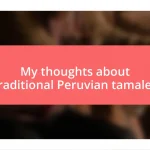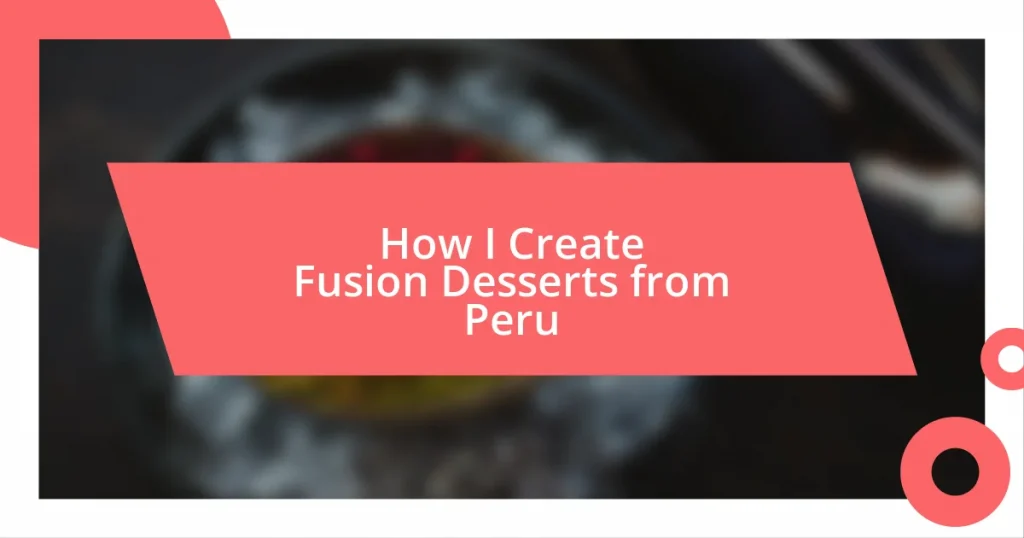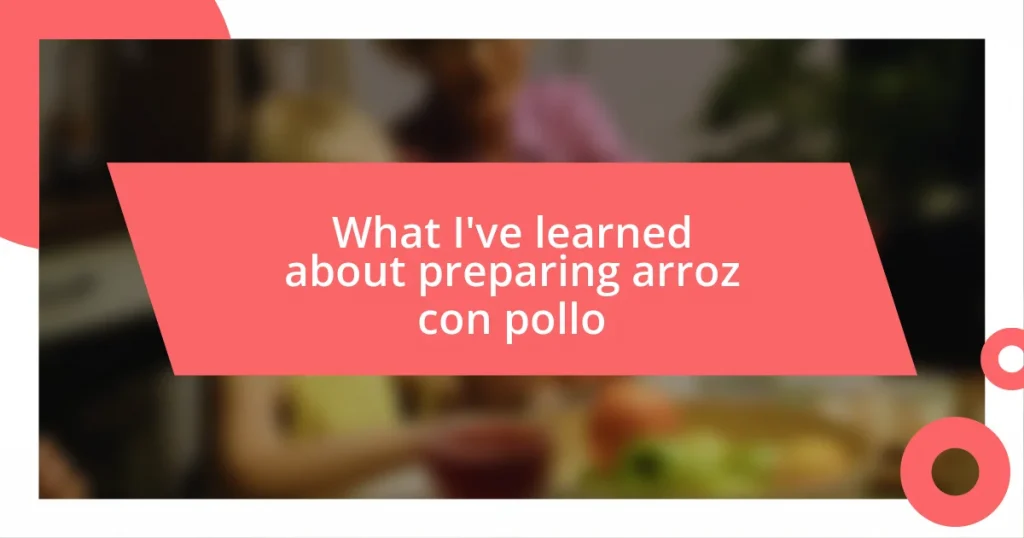Key takeaways:
- Fusion desserts blend diverse cultural flavors and ingredients, creating unique culinary experiences that tell a story.
- Incorporating Peruvian ingredients like lúcuma, maca, and alfajores enhances flavors and connects the creator with their roots.
- Successful dessert presentation involves vibrant colors, textural contrasts, and thoughtful garnishing to elevate the overall experience.

Understanding Fusion Desserts
Fusion desserts are a beautiful blend of flavors, textures, and traditions that come from merging culinary practices from different cultures. When I first tried a dessert that combined traditional Peruvian ingredients like lúcuma with classic French pastry techniques, it opened my eyes to how delightful and unexpected flavor combinations can be. Isn’t it fascinating how a simple idea of mixing cultures can lead to something genuinely innovative?
Many of my favorite fusion desserts come from experimenting with ingredients that I love. For instance, I remember the first time I made a tiramisu using Peruvian coffee and alfajores instead of ladyfingers. The creamy, rich layers combined with the sweet, crumbly cookies were a revelation. It made me realize that fusion isn’t just about mixing; it’s about telling a story through taste.
Exploring fusion desserts offers a chance to connect with others on a deeper level, as they often remind us of cherished memories or cultural roots. Do you recall the joy of discovering a dessert that took you by surprise? That thrill reminds me of why I dive into creating fusion desserts: it’s about sharing experiences, flavors, and a little piece of my heart with every bite.

Explore Peruvian Ingredients
Exploring Peruvian ingredients is an exhilarating journey. Each ingredient carries a piece of Peru’s culture and history. For instance, when I first worked with lúcuma, I was struck by its unique flavor—a perfect mixture of sweetness and earthiness. It inspired me to recreate a classic dessert like ice cream, adding that distinct twist that made it utterly unforgettable.
Here are some key Peruvian ingredients I love to incorporate:
- Lúcuma: This fruit has a sweet, maple-like flavor that pairs beautifully in custards and creams.
- Maca: Known for its earthy, nutty taste, it’s fantastic in baked goods or smoothies, adding both flavor and nutritional benefits.
- Cacao: Peru boasts some of the finest cacao in the world. I often use it to elevate chocolate desserts.
- Alfajores: These crumbly cookies, filled with dulce de leche, serve as an excellent base or topping in my fusion creations.
- Pisco: This Peruvian brandy adds a delightful kick to desserts, especially in sorbets or fruit-infused treats.
Using these ingredients not only connects me to my roots but also introduces my audience to the rich culinary tapestry of Peru. Each element invites exploration and experimentation, allowing me to create desserts that tell a story on every plate.

Techniques for Flavor Combination
When it comes to flavor combination, I often find myself experimenting with contrasting tastes. For example, I love balancing the sweetness of lúcuma with the tartness of fresh berries. The first time I paired these two, I was amazed at how the lúcuma’s creamy texture softened the bright, zesty notes of the berries, creating a dessert that was both rich and refreshing. It’s all about discovering that unexpected harmony.
Another technique I enjoy is layering textures, which adds a delightful dimension to fusion desserts. Recently, I made a churro ice cream sandwich using crispy fried churros and creamy vanilla ice cream infused with pisco. That crunch followed by the velvety smoothness was simply heavenly! It’s those little moments, like the first bite that encapsulates contrasting textures, that keep me excited about my creations.
I also believe in emphasizing regional spices, as they truly enhance the flavor profile of a dish. Imagine a chocolate mousse with a hint of cinnamon and a touch of aji amarillo. It was a revelation to me! The warmth of the spices complemented the richness of the chocolate, pushing the boundaries of what a dessert could be. Can you see how incorporating these spices opens up endless possibilities for flavor combinations?
| Technique | Description |
|---|---|
| Contrasting Flavors | Balancing sweetness with tartness (e.g., lúcuma and berries) |
| Layering Textures | Combining crispy and creamy elements (e.g., churro ice cream sandwich) |
| Regional Spices | Enhancing flavors with spices (e.g., chocolate mousse with cinnamon and aji amarillo) |

Popular Peruvian Dessert Bases
There’s something magical about alfajores, which I find to be a wonderful base for many of my fusion desserts. The first time I took a bite of one filled with rich dulce de leche, I had an epiphany! Their crumbly, melt-in-your-mouth texture pairs beautifully with various fillings or toppings, giving endless opportunities for creativity. Imagine them drizzled with dark chocolate or layered in a dessert parfait—it’s a match made in heaven!
Another remarkable dessert base is picarones. These sweet potato and squash doughnuts are a personal favorite. When I decided to infuse them with a hint of orange zest, it elevated their flavor to new heights. The added citrus lightened up the dish, transforming it into a tantalizing fusion treat. Who knew that a classic Peruvian dessert could be the star of a tropical twist?
Let’s not forget about choclo, or Peruvian corn, which has a unique sweetness that makes it an excellent candidate for base desserts. Last summer, I experimented with choclo in a pudding dish that combined coconut milk and a touch of cinnamon. I recall the moment I took my first spoonful; the creamy texture and subtle sweetness filled me with warmth and nostalgia. Isn’t it fascinating how traditional ingredients can bring back memories while encouraging new explorations in the kitchen?

Creating Unique Dessert Recipes
Creating unique dessert recipes is an exhilarating journey where every flavor and texture invites exploration. One of the most memorable moments for me happened when I decided to blend traditional Peruvian and Japanese flavors. I crafted a matcha tiramisu using layers of coffee-soaked biscochos and silky matcha cream. The marriage of the earthy matcha and the bold coffee was so unexpected yet comforting—it’s that kind of synergy that truly captures my passion for fusion desserts.
Sometimes, I find inspiration in unexpected places. For instance, while strolling through a local farmer’s market, I stumbled upon a variety of exotic fruits I had never encountered before. I bought a couple of them—each one burst with unique flavors. I experimented with a maracuyá and mango cheesecake that elevated the classic recipe to something vibrant and fresh. That first bite had me grinning from ear to ear, prompting me to wonder: how often do we overlook unique ingredients right in our backyard?
I’ve also discovered that collaboration can spark incredible innovation. A dear friend and I often share our culinary experiments, and one day, we decided to combine our ideas for a dessert event. The result was a dulce de leche panna cotta, artfully paired with a zesty lemon coulis. That sweet and tangy duo was a hit, and it made me realize that every dish we create carries a story—our own story, intertwined with every ingredient and technique we choose to embrace. Have you ever thought about the narratives your recipes tell?

Presentation Tips for Fusion Desserts
When it comes to presenting fusion desserts, I believe that the visual aspect is just as important as the taste. I often use vibrant colors from ingredients like fresh fruits or decorative sauces to create contrast on the plate. Once, I crafted a colorful layered dessert featuring meringue and picarones; the visual appeal was so striking that it almost felt like an artwork. Have you ever experienced a dish that just drew you in before you even took a bite?
Textural variety can take your dessert presentation to the next level. I love incorporating crunchy elements alongside creamy bases to keep the palate intrigued. For instance, I often sprinkle crushed nuts or cookies over a soft panna cotta to add that delightful crunch. When I first did this, I remember the satisfying sound as the spoon broke through—I could see the delight on my friends’ faces as they experienced that contrast.
Don’t underestimate the power of garnishing! Adding edible flowers or fresh herbs can elevate the sophistication of your dessert. I once gave a simple choclo pudding a makeover with sprigs of mint and edible blossoms. The surprisingly vibrant and fresh flavors paired beautifully and turned a humble dessert into a showstopper. Have you ever thought how a small addition can completely transform a dish?

Serving Suggestions and Pairings
When serving my fusion desserts, I often enjoy pairing them with complementary flavors that enhance the overall experience. For instance, my maracuyá and mango cheesecake is fantastic with a light, citrusy sorbet. The refreshing sorbet cuts through the richness of the cheesecake, creating a delightful contrast that makes each bite memorable. Have you ever tried a dessert that just seemed to dance on your palate?
Another favorite of mine is to serve my dulce de leche panna cotta with a sprinkle of sea salt and a drizzle of espresso. This combination not only balances the sweetness but also adds an unexpected depth to the dish. I recall the first time I served this; the look of surprise on my friends’ faces as they experienced the sweet and salty interplay was priceless. It’s these little surprises that keep culinary exploration exciting!
For a special touch, consider pairing my desserts with artisanal coffees or herbal teas. I find that a rich Peruvian coffee perfectly complements a matcha tiramisu, creating a harmonious blend of flavors. Sometimes, while enjoying the pairing myself, I reflect on how each sip and bite tells a story of cultural connection and innovation. Isn’t it delightful to think about the journey each ingredient takes to meet on our plates?















